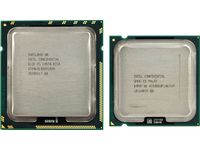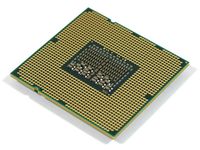The Hardware Behind Overdrive
CPUs: Core 2 Duo E8600 and Core i7 Extreme 965
We would have loved to use Intel’s latest Core i7 processors and X58 motherboards right from the start in order to provide all registered overclockers the opportunity to play with Intel’s new processor. However, since processor availability could not be guaranteed in all countries in sufficient quantities, we decided to stick with Core 2 Duo for the trials. This provides a proven and mature platform that most overclockers should be very familiar with.
Core 2 Duo E8600: 5+ GHz
We selected the fastest Core 2 Duo E8600 processor for our overclocking ventures, as this is the model that allows us to set the highest possible clock multiplier. As the processor clock speed is composed by multiplying the system base clock with the multiplier, a higher multiplier introduces more selection choosing settings that’ll yield faster overclocks. Intel’s Extreme Edition processors typically are the best choice for extreme overclocking, as they can be set to almost any multiplier. However, Intel stopped releasing dual core Extreme processors in favor of quad-core models.
Looking at the overclocking capabilities of many P45 platforms, such as the P45D3 Platinum provided by MSI, we can assume minimum system clock speeds of 500 MHz. This results in minimum overclocking speeds of 5 GHz when multiplying the system clock speed of 500 MHz with the E8600’s multiplier of x10. The further the overclockers go with the motherboards, and the better their skills in overclocking with liquid nitrogen, the higher the clock speed they will be able to reach—there are reports on the Internet of 6 GHz clock speeds achieved on a Core 2 Duo.
The Core 2 Duo E8600 is based on Intel’s 45 nm manufacturing process, and runs at a default core clock speed of 3.33 GHz using Intel’s 333 MHz front side bus in quad-pumped mode (FSB1333). We found that most of these processors reach 4 GHz with little overclocking effort; Core 2 Duo is still the best performing dual core processor, and also reaches the highest performance per watt ratings.
Also see:
Core i7 Extreme 965
Get Tom's Hardware's best news and in-depth reviews, straight to your inbox.
Intel’s next-generation processor is named the Core i7. It officially launched on November 17, but reviews were posted starting on November 3. While Core i7 keeps many architecture details of the Core 2 family, it also introduces a plethora of changes:
- Four cores per processor die rather than dual cores that are paired to create a Core 2 Quad with four cores.
- 8 MB shared L3 cache in addition to 256 KB L2 cache per core.
- Integrated tri-channel DDR3 memory controller. Memory speed depends on available memory multipliers, which differ among Core i7 models.
- Serial QuickPath Interconnect (QPI) replaces the front side bus. The interface can also be used to connect multiple Core i7 processors, which means that motherboards with two sockets can be created more easily.
- Reintroduction of Hyper-Threading, which provides two virtual processing cores per physical processing core.
Core i7 requires new motherboards for Socket LGA1366, due to the higher pin count required by the memory controller. All initial Core i7 models—the 920, 940 and 965 Extreme Edition—are rated at a thermal design power of 130 W. Core i7 is a new processor design that is based on proven manufacturing technology, but it is still difficult to predict its initial overclocking margins. The engineering samples that we received for the Core i7 review could be overclocked up to 3.8 GHz on air cooling. We’ll see how far the first Core i7 silicon can go during our Overdrive finals in France on December 13 and 14.
Also see:
Current page: CPUs: Core 2 Duo E8600 and Core i7 Extreme 965
Prev Page Overdrive Overclocking Championship 2008: The Components Next Page Platforms: P45 and X58

